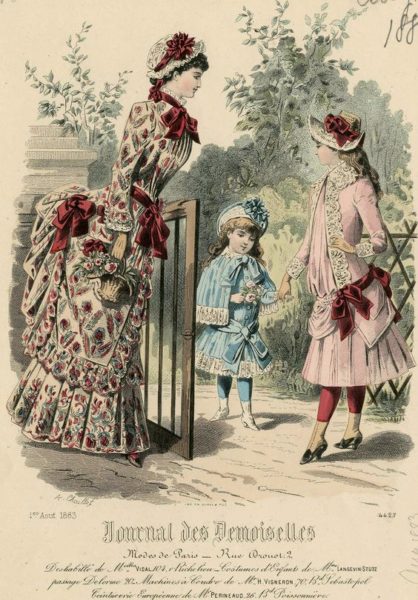
We have a lot of options for fabric selections when sewing up our Victorian ensembles. I personally like to use cotton and silk (taffeta) for most of mine.
Apparently, our ancestors had some varied choices, too…..

Like this plate above – 1883 Le Salon de La Mode – with a neat kind of print that looks like strips of masking tape…. but I’d like to see it with printed rulers. 😉
In researching fashion plates one can see the inclusion of large – excuse me, HUGE – prints on overskirts and bodices starting in the late 1870s.
However, 1883 seems to be “The Year of the Animal.”
These things have recently come across my path that makes me wonder “What the heck were they thinking??”
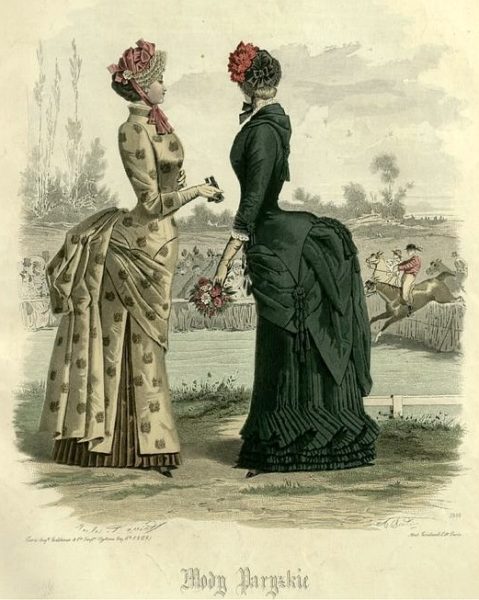
The 1880s seems to have some fabulous prints but then…. wait for it… roosters, pigs, horses and who knows what other kind of farm animals printed on perfectly good fabric and made into a draped bustle dress.
Whoa.
Like, that’s both cool and weird.
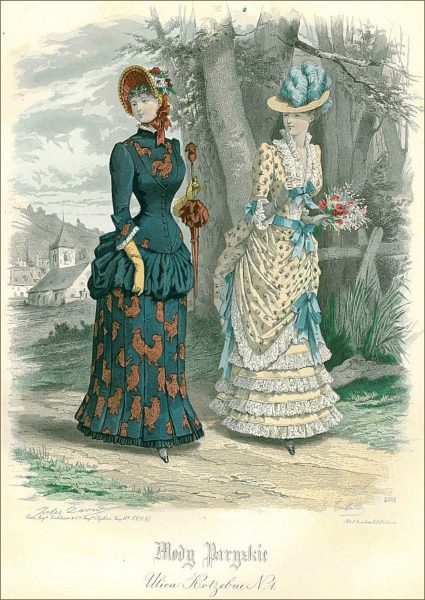
You can take those chicken curtains from grandma’s kitchen and make it into your next spectacular walking dress. Yay for The Curtain Dress!! Scarlett would be proud.

But then, it’s a bit freaky as who would think to take that lovely cow cotton print (you know, the one to make a barbeque apron for the hubby) and merge it with some lace and buttons for the full-on Victorian tea gown??
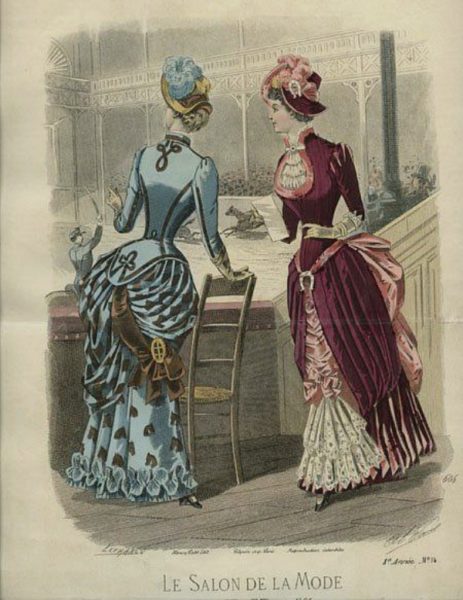
Most of these “unusual” dresses appear to be for walking or for some sort of sporting event – horse racing, by the seaside, at the park.
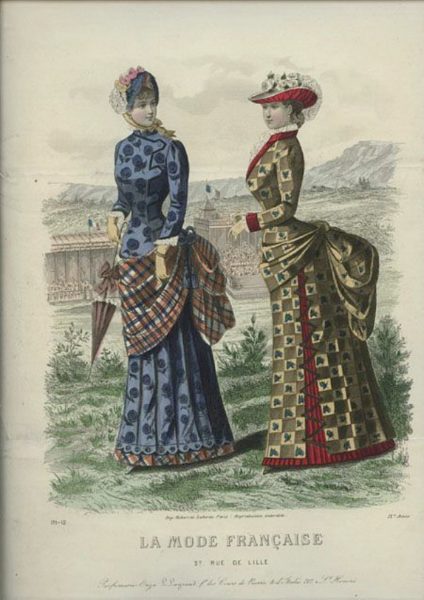
In my brief research I found that Victorians with their [Industrial] revolutionary ideas and promoting beauty and value, animals became quite the figures of honor.
In the book Women Poets in the Victorian Era: Cultural Practices and Nature Poetry, author Fabienne Moine states: “According to James Turner, the Victorian public chose to give animals a heart and mind, ‘an image so appealing that it not only quelled the fears of man’s bestial past but served as an emblem of the heart and an example to the human race’…. The Victorians were ready to welcome animals into their social sphere and women were in the vanguard of this process.”
For more cultural research on horses in the Victorian Era, the new book, Victorian Fiction and the Cult of the Horse by Gina M. Dorre’, might be of some interest.
Although, I couldn’t really find much on roosters or chickens in popular culture and why women used them on their dresses. (If you know of such sources or stories behind this fad please share!)
And if you don’t like horses or chickens you can always go with a stuffed cat on your hip. Oh, Fluffy!

What say you on this weird fashion trend of 1883 using prints of farm animals?

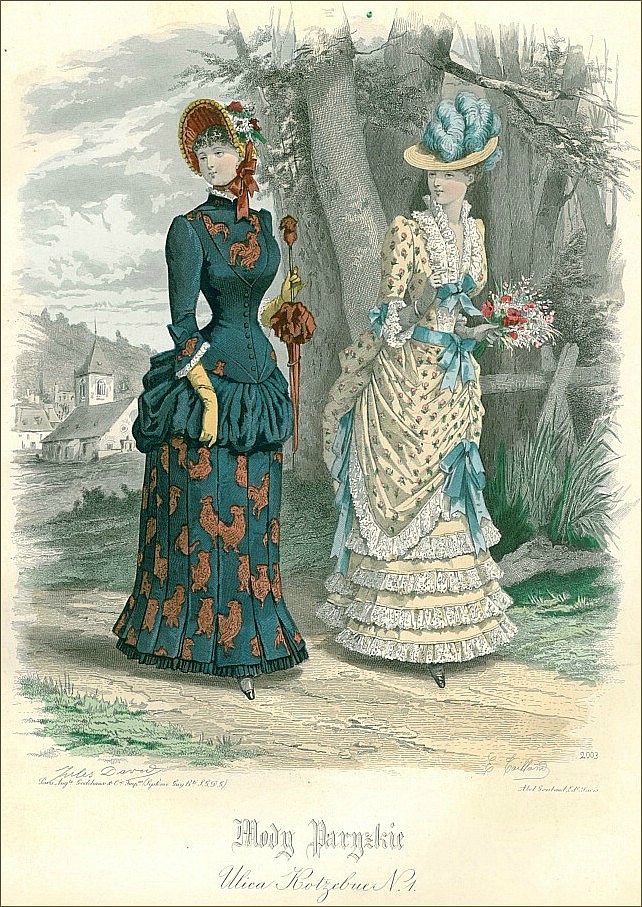
I totally found a hat with a stuffed kitten head on it in a local costume exhibition a couple of years ago. It was from the 1880s. I think. I took pictures. Bad pictures, due to low light and a glass barrier, but still.
Wow! And how fun to see an original example of this crazy Victorian animal phase.
What kind of bustle would be under these dresses? Some of them seems to be natural forms and some no. I’m quite tempted to attempt making the rooster one!!
You can review my post on the three distinct styles of the Bustle Era here. Then when ready to sew, I have a post on recommended patterns to achieve the various silhouettes of the 1870s and 1880s.
Thanks for your answer! I’ve been following your blog for a while but I’ve been too shy to comment. Thank you for your work, it’s really appreciated.
Thanks for reading, Genevieve! Glad you’re part of our Joyful Community. 🙂
That’s it. I’m saving all the hair that her lovely Ladyship, Molly, the Dutchess of Fuzz, leaves behind her *everywhere*, including everything I can salvage from enthusiastic brushing and from the dryer, and then I’m going to spin it until I have enough beautiful, soft, dark grey yarn to talk my mum into crocheting me a mini-Molly for a dress and a matching pouf for a hat. Because I might be able to sew, and even embroider quite well, but other forms of needlework have always escaped me, and I *NEED* that cat dress, made with real cat and no cruelty. Though her Ladyship might debate whether brushing counts as cruelty…
LOL!
I already do things like this with 1950s dresses. I have 50s-style dresses with harvest corn, Darth Vader, Black Widow, pine branches, and fluffy bunny fabrics. I also bought some blue sheets with white polka dots and bananas on them…to use as fabric for a dress. So, I’m 1,000,000% in favor of this absurdity! 😀
Also I REALLY wanted to make a dress when Captain America: Civil War came out…that was a hoop-era dress, designed to evoke the look of Black Widow’s outfit. I just never got around to it…and it seems like it may be a little too late now.
It’s never too late! 🙂
Lol!! Based on your comment, I started thinking about how I could make my husband an 1860s Captain America or Iron Man costume so that we could have a theme and really make it work.
He told me that he would prefer to be Iron Man because then he can walk around with a gin & tonic…and also because he isn’t blond and bulky like Cap (my husband is 5’6″ and around 125 pounds). It was pretty adorable, and now I’m really excited about doing this costume set.
Thanks for the inspiration!
I’d seen the one with the cat hanging on the side of her hip but its the first time I noticed the cat head on her hat. The artists of these fashion designs were surely having a lot of fun, but I wonder how many women actually did that?
I wonder from the responses here so far of how many now we will start seeing. *grin*
Val
I’ll have to dig up the picture from the lady at the Vanderbilt Fancy Ball in 1897, I think. The lady has a white cat on her head and then multiple cat tails on her dress. That era was responsible for the decimation of many birds and other creatures.
Photo of lady here.
I want llamas on mine!
Yes! A sproinging llama!
Or Cuzco. Actually, I’ve been wanting a piece of clothing with the dead lizard motif from Modka’s Meat Hut! No idea why, except it cracks me up every time I see it.
I found this whole article hilarious! Since people used to wear fox fur complete with head and paws I shudder at the stuffed cat style! Did fox fur stle come later?
How have I never noticed these before? Brilliant article, thanks for sharing. I really hope someone will make a crazy animal-print dress now, although not sure I’d be brave enough for it myself.
I didn’t notice until now either! And it really is out of the ordinary for Victorian wear. Sure, animal prints had been worn before, but somehow in 1883 it was all the rage. So weird of a fad!
Do you have any suggestions on how to make a cat for the dress? Especially punk’d. Totally cool idea.!!! I’d skip the fur balls. Too weird for my taste. Chickens on the dress is cool too, that is if you are really into it.
Hmm.. not sure. What about a stuffed animal toy?
I was thinking it be knitted! That’s how I wanna do it
Yip, I totally thought of daleks when I first came across that dress!
I absolutely love finding fashion plates that show different prints than we expect them to have had =)
I love it but yikes! What were they thinking?
Yes! I want a cat fur dalek dress.